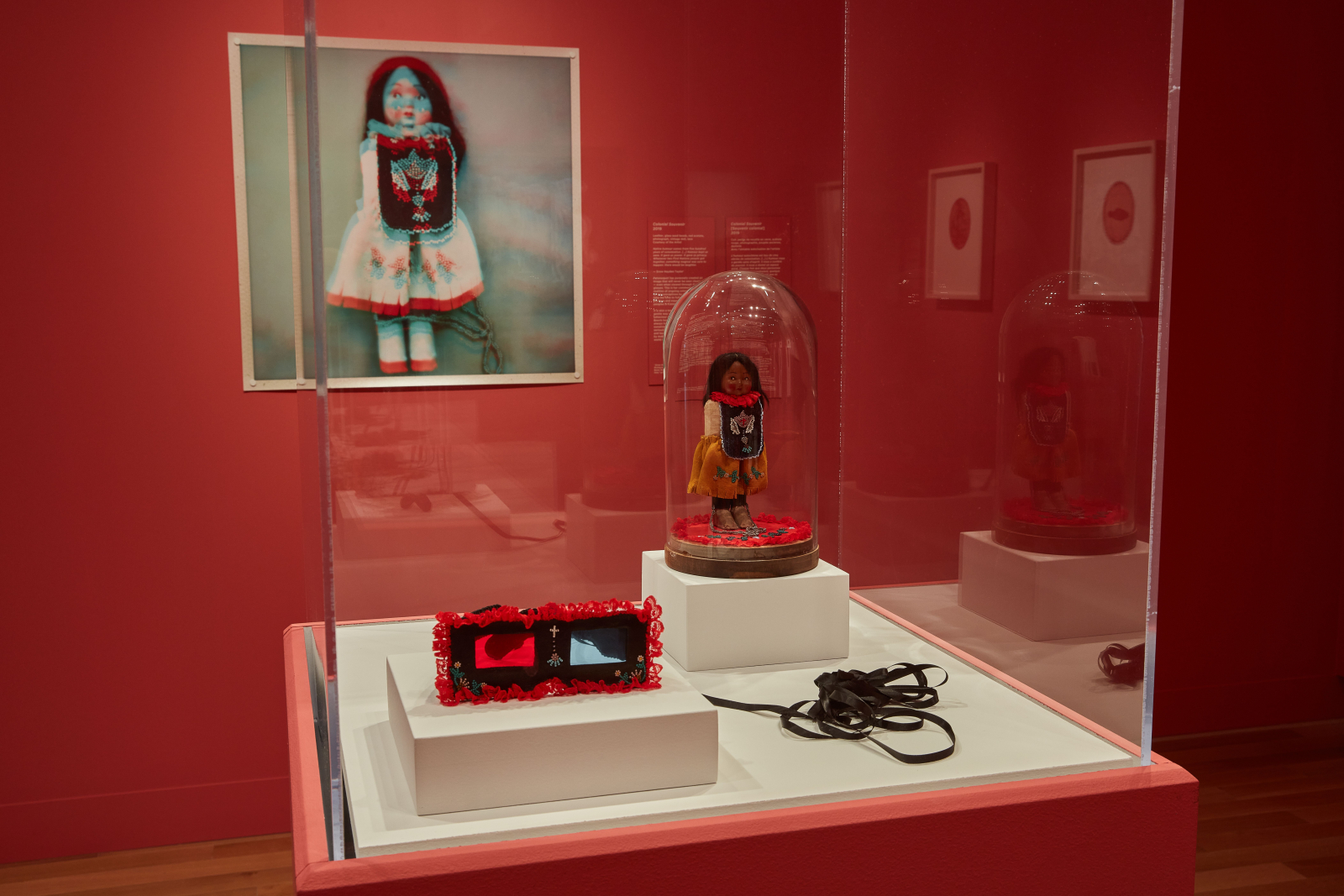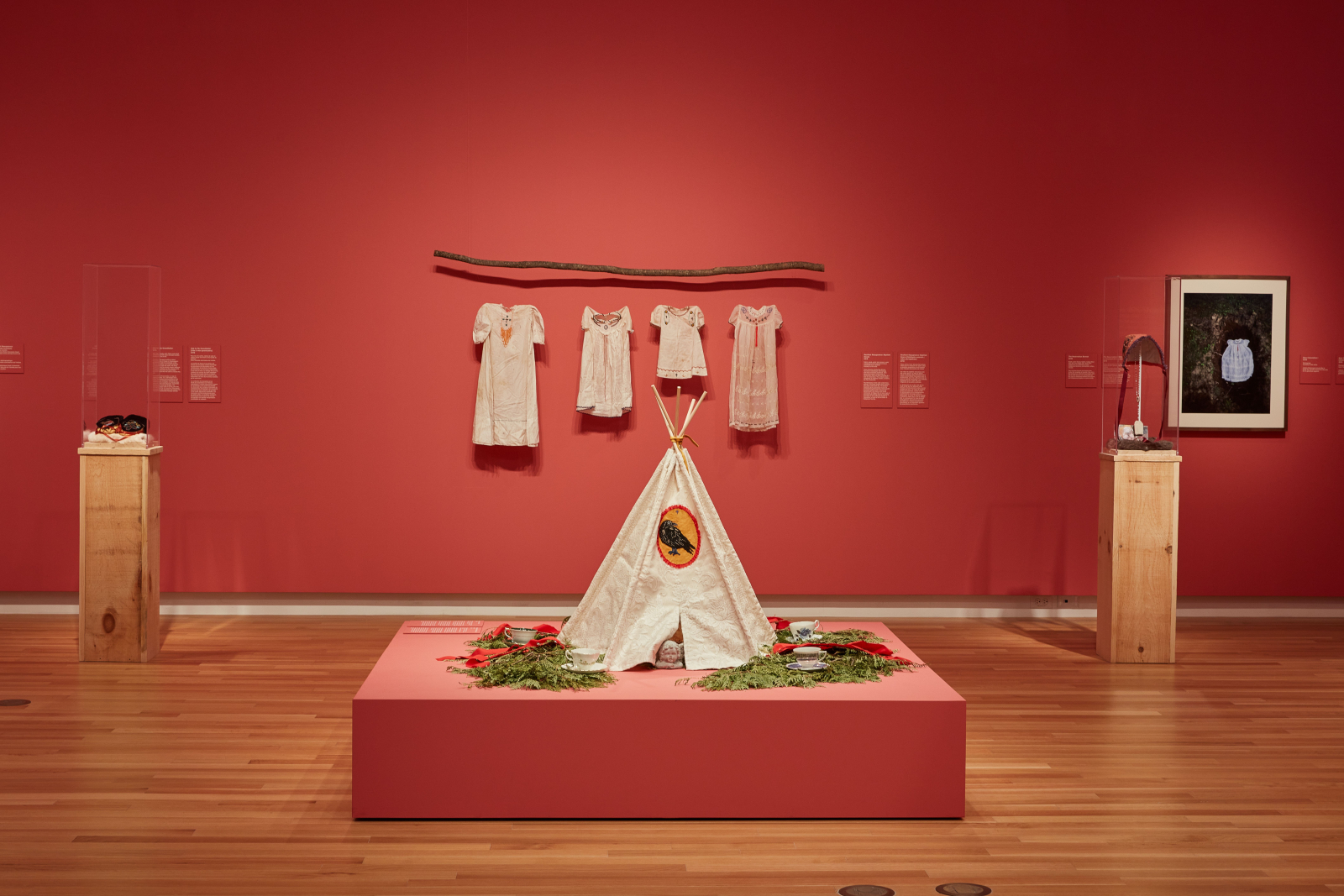Content warning for Indigenous readers: Petonoquot work touches on serious themes.
Jobena Petonoquot, an artist from the Algonquin Nation of Kitigan Zibi Anishinabeg, opposes souvenir shops that sell Indigenous memorabilia.
That makes souvenirs, and settler symbolism, the perfect foil for her art. Petonoquot’s works challenge the colonial gaze that inspired the shops, and assimilation, to begin with.
“I was thinking about the idea of the souvenir. It’s meant to represent a particular place, to speak of that place, and it didn’t relate to me,” Petonoquot told Canada’s National Observer. “Souvenir shops are trying to sell an idea, to decolonize the Native to say we were never colonized.”
In Colonial Souvenir, Petonoquot dressed and beaded a stereotypical Indigenous doll and enchained it with a rosary. She photographed the doll and distorted the image in red and blue. 3D glasses sit beside the blown-up photograph. When you put on the glasses, nothing happens. The doll remains two-dimensional and the viewer is pranked.

It’s a serious joke: a trick on a viewer accustomed to stereotypical portrayals of Indigenous peoples in popular culture. The photograph of the doll is a supposed 3D image that remains 2D. It’s a work that pokes fun at the souvenir unblemished by colonialism.
“I did it as a joke because we are still in a colonial state,” Petonoquot says, referring to unmarked graves, MMIWG, and everyday racism. “A lot of these little things are dangerous to our people, it’s damaging to our identity.”
The theme of the trick or joke plays throughout Petonoquot’s works. Take beadwork, it’s meant to tell a story, Petonoquot says. It’s a tradition that began with materials like shells and porcupine quills before Europeans introduced beads. But the beads, in all their beauty, tell an ugly story of how colonialism fundamentally altered Indigeneity on these lands.
Colonization forced Indigenous peoples to westernize through religion and assimilation policies. Now Petonoquot is Indigenizing symbols of the Crown, Christianity and Canada to confront the settler viewer. For example, teacups, baby bonnets, dolls, crosses, the oil painting Jack Pine all become Indigenized through Petonoquot’s work.
“Beads are very European, and I’m taking something that I use all the time, and it’s not Indigenous, but I’m taking it and making it my own to tell a story about what happened to our people,” Petonoquot says.

In Gins of the Church, Petonoquot pays homage to her grandfather. In the piece, a beaded rosary sits within a rabbit trap, similar to what her grandfather would’ve used in opposition to the laws that sought to dispossess his ability to hunt. It’s a doubling work: her grandfather trapped by his era and the viewer ensnared by Petonoquot to confront that era.
“I’m being sarcastic. People comment: ‘Oh, your work is so beautiful and so powerful’ and I feel like I’m using it like a trap,” she says. “I know how to make beautiful things. That’s what I was put on this Earth to do, but I use it in a way so people look and realize how ugly it is.”
In one flagship piece, Resilient Repugnance: Buried Dress, her rebellion is on full display. In it, Petonoquot carefully beaded four baptismal gowns before burying them. Later — the timing doesn’t matter, Petonoquot says — she unearthed and displayed them.

It’s an act of remembering that never forgets the violence committed against Indigenous children. It’s also an anticipating piece, done three years before the finding of the 215 unmarked graves in Kamloops.
“It’s not just an Indigenous problem, it’s a Canadian one, as well,” Petonoquot says, implicating the settler viewer.
In Rebellion of my Ancestors, Petonoquot fights the forces of colonialism in a gentle and pranking way to reclaim her ancestors' dignity as Algonquins.
“My main goal as an artist is to become a human being,” she says.
Matteo Cimellaro / Local Journalism Initiative / Canada’s National Observer
Jobena Petonoquot
Rebellion of my Ancestors | Nid Ànike-mishòmisibaneg Od-Àbimìtàgewiniwà
March 26, 2022 - Aug. 14, 2022
Curators: Rebecca Basciano, OAG; Lori Beavis, guest curator and executive director, Centre d’art daphne






Comments